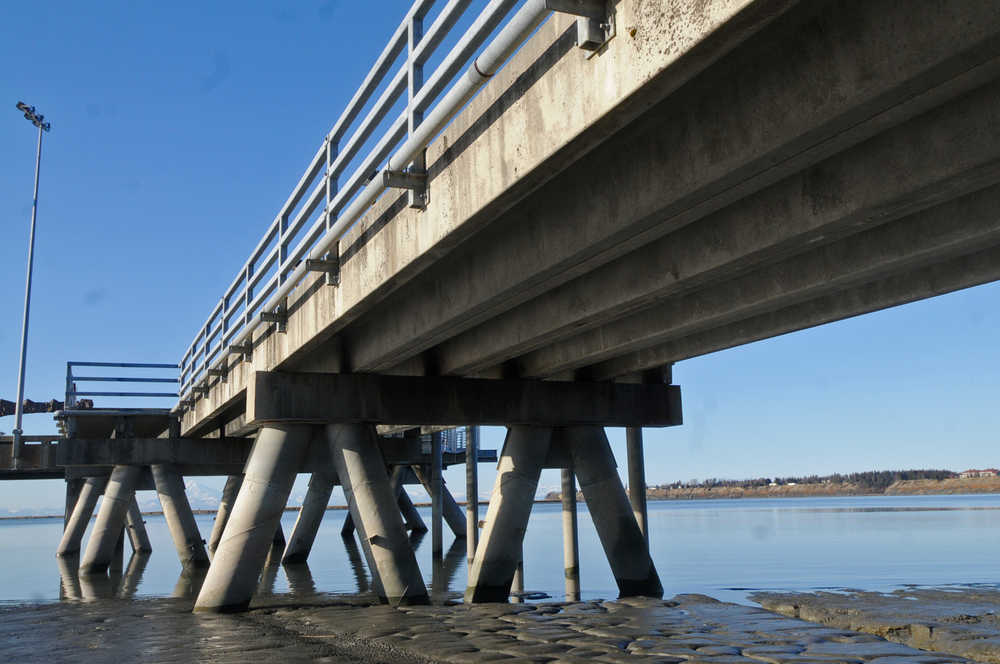In addition to a gasline rupture and subsequent explosions on Kenai’s Lilac Lane, the 7.1-magnitude Iniskin earthquake that hit the Cook Inlet region on Jan. 24 may have caused more subtle damage to Kenai’s dock.
The Kenai dock consists of a deck and a trestle supported by pilings — concrete cylinders with a steel bar in the center. On Feb. 9, 2016, engineer Matthew Dura of Kenai-based firm Nelson Engineering took a boat underneath the dock with two City of Kenai employees to inspect the pilings, deck, and trestle for damage from the Iniskin quake.
Dura found cracks and spalling — a type of damage where concrete falls from a structure in flakes or chips — in five locations near the joints between pilings and the girders underlying the deck. Based on the prevalence of water-staining and mold inside the cracks, he estimated that four of the locations had been damaged recently.
Dura’s Feb. 22 report to Kenai Public Works Director Sean Wedemeyer recommends eight repairs to the dock, most to hairline cracks in the concrete piling casings, in which mineral deposits could cause eventual corrosion to the steel bars inside. Dura wrote that these fractures don’t presently harm the carrying capacity of the dock, but in the long run “will eventually reduce structural capacity of the dock and should be monitored with regular inspections to ensure the safety of dock users.”
In the four locations with recent spalling damage, Dura recommended replacing the loose concrete with grout or epoxy and reattaching the pilings to the girder below the deck. He also recommended using plates to reinforce a cracked connection between a beam and trestle girder where cracking “has significantly reduced the capacity of the connection.”
The only damage Dura found above the deck were two places at which guardrail anchors were cracked — damage more likely from a vehicle impact than the earthquake, Dura wrote.
“(Dura’s report) did indicate that the dock was still structurally sound and normal summer operations could take place,” Kenai Finance Director Terry Eubank wrote to Kenai City Manager Rick Koch in a Sept. 1 memo. The dock remained open for the 2016 season. At its Sept. 21 meeting, the Kenai City Council unanimously approved an ordinance appropriating $35,000 for a study of the required repairs, also to be done by Nelson Engineering.
The study will determine the cost of repairs, but Eubank guessed they would be between $100,000 to $250,000. Kenai’s insurer, Alaska Public Entity Insurance, has a $25,000 deductible on earthquake coverage, Eubank said. To what extent insurance will pay for dock repairs, however, depends on determining what damage to the 30-year-old dock was done by the earthquake and what is due to age.
Dura wrote in his report that “the majority of small cracks … had mineral deposits, and some had mold growth, indicating they had been present for some time prior to the most recent earthquake. In addition, the heavy rebar corrosion and water staining found in some of the spalled locations indicated water intrusion prior to the Iniskin earthquake.”
Money for the repairs would likely come from the city’s general fund, and Eubank said it would be unlikely to increase dock fees.
“I don’t think there’s any way we could raise it through user fees except through the personal-use fishery, and those fees are about as high they’re going to get for a little while,” Eubank said.
Although the boat ramp near the dock sees heavy recreational traffic during the July personal-use dipnet fishery — during which Kenai charges recreational boaters $35 to launch — “virtually everything that goes on on the main structure (of the dock) is commercial-related,” Eubank said. Commercial fishing boats pay $25 to use the main dock.
The nearby Copper River Seafoods cannery leases the dock from Kenai for $65,000 a year, an amount Eubank said more than covers normal maintenance costs, though the repair money would not come from this lease.
According to his memo to Koch, Eubanks expects to ask the council to appropriate repair funding in early 2017, allowing repairs to be made that spring before the start of the summer fishing season.

